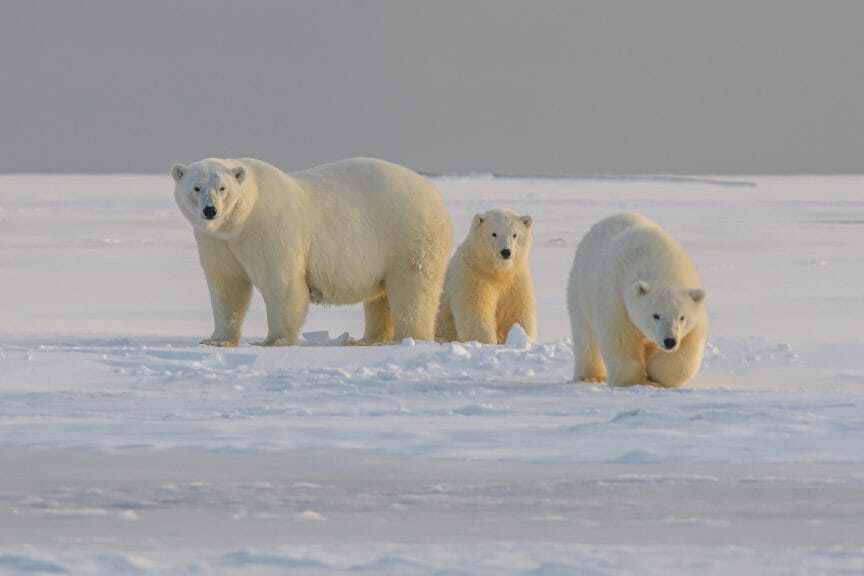In groundbreaking research, scientists have established a direct link between human-generated greenhouse gas emissions and the reproductive and survival rates of polar bears, marking a significant step toward understanding and safeguarding this iconic species.
Polar bears, found in 19 populations across the Arctic spanning Canada, the United States, Russia, Greenland, and Norway, are uniquely dependent on ice sheets to access their primary food source—seals. However, climate change fueled by human activity is rapidly eroding this critical habitat, pushing polar bears to the brink.
A collaborative effort by researchers from Polar Bears International, the University of Washington, and the University of Wyoming has quantified the connection between the number of ice-free days polar bear populations endure and the cumulative emissions of planet-warming pollutants. Their findings, published in the journal Science, provide a compelling argument for the direct link between emissions and polar bear survival rates in specific populations.
Historically, the connection between human-caused climate change and its impact on polar bears has faced skepticism and bureaucratic hurdles. Although polar bears were designated as “threatened” due to climate change under the US Endangered Species Act in 2008, the government didn’t have to consider emissions when approving projects, as a direct link had not been established.
This new research bridges that gap by examining polar bear subpopulations that have endured ice-free seasons for over a decade, from 1979 to 2020, tracking the increasing number of days these bears were forced to go without food as greenhouse gas emissions accumulated. The results are staggering, revealing that each additional day of fasting corresponds with every 14 gigatons of greenhouse gas emissions released into the atmosphere.
Subpopulations in areas where ice sheets usually melt entirely during the summer are experiencing a sudden and drastic shift in their environment. Bears are now enduring more forced fasting days, which they did not face in the past. This critical research builds upon a 2020 study that demonstrated the connection between ice-free days and declining reproduction and survival rates among polar bears.
The findings have significant implications for conservation efforts and policy decisions, highlighting the need for immediate action to mitigate climate change’s impact on polar bears and other vulnerable species. Additionally, this research serves as a potential template for protecting other species threatened by human-induced climate change under the Endangered Species Act.
While the road ahead remains challenging, this study underscores the importance of acknowledging the far-reaching consequences of our emissions on the delicate balance of life in our world’s most fragile ecosystems.
The groundbreaking study on polar bear survival rates in the face of climate change has broader implications that extend far beyond the Arctic ice. It serves as a clarion call for a paradigm shift in how we approach the conservation of species threatened by human-induced climate change. As Kirsten Zickfeld, a distinguished professor of climate science at Simon Fraser University in Canada, aptly noted, this research reveals a vital shift in our understanding of the intricate connections between emissions, climate change, and the survival of not just polar bears but potentially countless other species.
Previously, we knew that human activities, primarily the release of carbon dioxide and other greenhouse gases, were driving changes in our climate. Now, the research by Amstrup and Bitz pushes the envelope further by demonstrating that these emissions also directly affect ecosystems and the survival of vulnerable species. It’s a critical leap that allows us to trace the decline in polar bear populations back to individual sources of carbon emissions.
This study has profound applications, serving as a blueprint for researchers and policymakers working to safeguard other species threatened by climate change. By establishing a direct link between emissions and the survival of polar bear cubs, we now possess a powerful tool to advocate for stronger conservation measures.
But let’s not forget that polar bears are just the tip of the iceberg. In the grand tapestry of life on Earth, countless species are grappling with the repercussions of our carbon footprint. With this research as a guiding light, we can strive for more targeted conservation efforts and advocate for stronger climate policies.
The implications are far-reaching. For example, each of the hundreds of power plants in the United States may make a seemingly small contribution to emissions, but collectively, they emit nearly 2 gigatons of greenhouse gases annually. Over the 30-plus year lifespan of a polar bear in the southern Beaufort Sea, this adds up to more than 60 gigatons of emissions. As a result, these emissions translate to an extra day of fasting for each 23 gigatons added to the atmosphere. This seemingly small impact compounds over time and translates to a 4% reduction in the survival rate of these magnificent creatures.
As climate change continues to shape the world around us, this research reminds us of our profound responsibility to protect the diversity of life on Earth. It’s a clarion call to take collective action, reduce emissions, and forge a more sustainable path forward, not just for polar bears but for all species that call our planet home. This study offers hope that by understanding the intricate connections between emissions and ecosystems, we can pave the way for a more harmonious coexistence with the natural world. The fate of polar bears and countless other species now rests in our hands.






